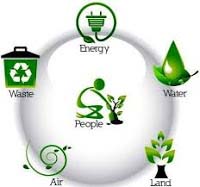350 Ventura County Climate Hub Input for Policies
Carbon Sequestration Section of Climate Chapter
GOAL A – Create a greenhouse gas accounting framework with spatially explicit inventory and baseline data for below and above-ground carbon, as well as other greenhouse gases related to land management.
POLICIES
- Land Management and Multi-Benefit Assessment Tools. Work with state agencies and NGOs to deploy the most appropriate available tools and protocols for defining baselines, setting targets, and tracking changes in carbon sequestration.
- Maps. Make plans and strategies using maps showing vegetation densities layered with carbon density and habitat suitability.
- Collaborate to set and track targets. Develop partnerships with Cal State University Channel Islands, University of Santa Barbara, Ventura County Community Colleges and non-governmental organizations to oversee the setting and tracking of carbon sequestration targets for different land uses and cropping systems.
- Mitigation ratios tied to carbon density. 4:1 minimum mitigation ratios will be applied to impacts to healthy forest, multi-strata agroforestry, riparian cottonwood stands, and coastal wetland and riparian habitat, and highly carbon-dense deep-rooted perennials to protect the county’s existing and expanding carbon sinks.
- Adaptive management. Plans to meet carbon sequestration targets must integrate a monitoring program that is able to detect the needed information for strategy evaluation and incorporate feedback loops to link implementation and monitoring to the decision-making process that also takes advantage of new technologies and climate protection science to discover continuously higher-level, more comprehensive approaches to match the scale, variety and difficult predictability of climate hazards.
PROGRAMS
Land Management and Multi-Benefit Assessment tool to be completed during 2018 for use by all counties. Short slide presentation here.
Farmland Mapping and Monitoring Program (FMMP)
Strategic Agricultural Lands Conservation(SALC) Program
Merced County Collaboration is a model for land use, land management and conservation activities.
BACKGROUND
Beginning numbers for a breakdown of County’s land categories by number of acres for purpose of defining existing and potential carbon sinks:
Forest/Woodlands (federally owned)
Forest/Woodlands (non-federally owned)
Shrublands
Grassland – 200,000 acres
Grazing land – 198,000
Wetlands – 1500 Mugu Lagoon, historically 3,000, could be three times that countywide in the 3 watershed estuaries and riparian areas?
Barrren
Orchards (woody perennial crops-fruit and nut trees) 43,500 acres
Vineyards – some of the 43,500 above?
Annual vegetable crops (conventional, i.e. artificial N inputs) 37,300 ac
Annual crops (regenerative/sustainable/organic/biodynamic) 8,200 ac
Nonwoody perennial crops 100 acres herbaceous perennials
Irrigated pasture
Urban and built up 106,000 (how to inventory trees and community forests)
GOAL B: Increase biological carbon sequestration on forested lands [1 million MT CO2/yr very rough guess].
POLICIES
- Urban Forestry Advisory Committee. Establish a countywide advisory committee of similar make-up to the California Urban Forestry Advisory Committee to promote the increased protection of forested lands including community and urban forests and riparian cottonwood forests, and reduced conversion to non-forest uses.
- Collaboration. Develop partnerships with the owners and managers of forested lands, federal and non-federal, and develop and implement a plan to expand and improve forest management to improve forest health and resilience
- Wildland-urban interface. Develop and implement best management and building code practices to minimize wildfire risk along the wildland-urban interface.
- Private-owned foothill chaparral and forests. Develop a program to measure and reward increasing carbon sequestration in private-owned forests.
- Afforestation. Restore ecosystems in degraded, barren and wildfire- and pest-impacted areas by planting mixed native species that provide multiple benefits including economic revenue.
- Controlled burns and natural processes. Restore the fire regime that renews soil, aids dispersal of seeds, and thins out less desirable species while reducing fuel hazard and restoring forest structure.
- Tree pests as superior thinning agents.
- Leaving trees where they fall. Educate land managers and those who do forest management and landscape maintenance that dead trees and branches are vital components of forest and landscape ecosystems and should be removed only when necessary because they are long-term storage systems for carbon.
- Mountain meadow wetlands. Map and restore mountain meadow wetland habitat.
- Establish funding mechanisms for conservation. Create a mitigation fee system to fund purchase of development rights to protect and conserve heavily wooded areas.
- Transfer Development Right. Support TDRs and density transfers designed to protect carbon density on existing forest land.
- Enterprises to support forest restoration. Innovate solutions for wood products and biomass utilization to support ongoing forest management and restoration activities.
- Protect and Increase urban trees. Create inventory and set targets for tree protection program and for planting more street trees and more parks with trees with a minimum target of 500 street trees in underserved communities by 2021 from 2016; 15 percent increase in total trees by 2025 from 2021; 35 percent increase in total trees by 2030 from 2021; 50% increase in total trees by 2040 from 2021.
.
PROGRAMS
EcoRestoration in Ventura River Watershed-Demonstration of stormwater capture to maintain aquifers in Ojai Valley and Ventura River watersheds may include forest restoration and riparian habitat with native plant species.
Forest Carbon Plan designed by CARB recognizes the Los Padres National Forest as in the state. Several regulatory, policy, and financial challenges have hindered the ability of the Forest Service and Department of Interior agencies (Bureau of Land Management and National Park Service) to increase the pace and scale of restoration needed, such as funding for wildland fire suppression and the procedural requirements of federal environmental and planning statutes. The State of California and Ventura County have a vested interest in working closely with the federal government to help resolve these obstacles and to achieve forest health, resilience and the expansion of carbon sequestration on the lands that federal agencies manage.
Urban Forestry Advisory Committee will implement policy 13 to protect and increase urban trees.
JUSTIFICATIONS
Forests hold far more carbon than any other ecosystem.
Forest restoration mitigates flooding.
Forest restoration and good management provide many co-benefits: groundwater recharge, water quality, wildlife and beneficial insect habitat, biodiversity, scenic beauty and recreation.
Dead trees store carbon for decades. As they decompose, much of their carbon returns to the soil, where it is held for thousands of years. Large-scale removal of dead tree material disturbs carbon sequestration. Burning wood releases carbon and worsens air pollution. Messy woods are good for wildlife – creating snags, cavities, brushpiles, and other structural elements that protect and provide cover and resources for a diversity of wildlife. Dead trees and brush can be moved for paths and recreational areas without clearing them.
Afforestation is planting forests where they haven’t been, as described in Drawdown- Afforestation. Fast-growing, dense plots of native species can draw down carbon, while supporting biodiversity, addressing human needs for firewood, food, and medicine, and providing ecosystem services such as flood and drought protection explaining why on a global basis the net savings from this solution is expected to approach $400 Billion.
GOAL C- Increase biological carbon sequestration on farmland, grazing land, and other non-forested, non-wetland, natural and working lands [1000 MT CO2/yr very rough guess].
POLICIES
- Inventory and baseline for below and above-ground carbon on farm and grazing land. Create a program to track achievement of targets for carbon sequestration on working lands, including rangeland carbon farming.
- Partnerships. Facilitate local partnerships to determine targets and strategies for expanding carbon sinks on working lands.
- Science-based technical assistance. Study and promote knowledge and understanding about best practices for biological carbon sequestration including on-site water harvesting, green growth, and healthy soils in integrated natural systems to preserve and enhance natural and working lands including trees, vegetation, and soils.
- Restoration of small water cycles. Promote best practices for restoring small water cycles by appropriate stormwater harvesting to support revegetation, particularly of native species, to include healthy trees which are “nature’s most efficient carbon sinks” and are sources of microbial nuclei associated with formation of raindrops.
PROGRAMS
Healthy Soils Initiative – a collaboration of state agencies led by CDFA to promote the development of healthy soils on farm and ranchlands through grants for innovative practices that contribute to building soil organic matter to increase carbon sequestration and reduce overall GHG.
Carbon Farming Rewards Program – A collaboration of local organizations to develop, test, demonstrate, and document achievements in carbon sequestration. Identify working lands with above average potential for carbon sequestration including deep-rooted perennial grasses by applying compost, and support increasing availability of local compost for application to prioritized lands for carbon farming. Reward appropriate achievements on an annual basis using the most simple, common sense metrics, toward short- and long-term targets for carbon sequestration inviting all owners or managers of working lands of two acres or more in size potentially including as a secondary priority public lands, regardless of the number of property owners and regardless of when or by what strategy the carbon was sequestered.
JUSTIFICATION
Healthy soil is the best medium for growing healthy, resilient, disease and pest resistant plants in part because the interaction of soil microbes with plant roots supports an optimal soil-carbon sponge and provides the cation exchanges and symbiosis with fungi that screen out toxic minerals and optimize plant mineral content for highest nutritional value.. (http://www.nrcs.usda.gov/wps/portal/nrcs/main/national/soils/health/).
Health of agricultural soil relates to its ability to build and retain adequate soil organic matter via the activity of plants and soil organisms. Adequate soil organic matter ensures the soil’s continued capacity as a vital living ecosystem with multiple benefits for producing food for animals and humans. The multiple benefits of healthy soil include:
- Provides nutrients that support plant growth, biodiversity and yields.
· Increases water infiltration, reduces runoff, able to hold up to 20 times its weight in water; assists flood management.
· Sequesters carbon reducing greenhouse gases - Reduces sediment erosion and dust
- Improves water and air quality by reducing emissions of criteria pollutants and the persistence of pesticides in soil and water.
· Improves habitat for wildlife and beneficial organisms including a diversity of soil-borne organisms that constitute a quarter of the world’s species.
GOAL C – Increase biological carbon sequestration in coastal and riparian wetlands [1000 MT CO2/yr very rough guess-or a 5 yr target].
POLICIES
- Inventory wetlands and set targets and strategies. Collaborate with the cities, districts and the Naval Bases to inventory all existing and former wetlands to set targets and strategies to prevent destruction of wetlands that would be a source of carbon emissions if disturbed.
- Collaboration. Work with land conservancies, the Naval Bases and other organizations to map and set targets for numbers of acres of expansion of wetlands through restoration or mitigation.
- Protect and conserve wetlands. Prevent toxic runoff into streams, estuaries and wetlands that may reduce carbon holding capacity and harm wildlife.
PROGRAM
Blue Carbon Project Such a project can be started here to provide many services including protection from storms and erosion, tourism benefits, and climate adaptation and mitigation. Coastal ecosystems with seagrasses, salt marshes provide climate mitigation services because they are effective at sequestering and storing carbon dioxide, referred to as “coastal blue carbon”. Degradation of blue carbon ecosystems from land use impacts, identified in the inventory, would prevent their service as a carbon sink.
JUSTIFICATION
Wetland ecosystems provide an optimum natural environment for sequestration and long-term storage of carbon dioxide (CO2) from the atmosphere; however they are also natural sources of greenhouse gas emissions, especially methane. It has been shown that most wetlands can be created and restored to provide carbon sequestration and other ecosystem services without great concern of creating net negative impacts due to methane emissions.
GOAL E – Reduce food waste [1000 MT CO2/yr very rough guess-or a 5 yr target]
POLICIES
- Inventory food waste and set targets. Work with the Ventura County Farm Bureau, Chamber of Commerce, business organizations, colleges, and NGOs to assess the sources and amounts of food wasted in the county and set 5 and 10 year percent reduction targets.
- Gleaning. Promote programs that reduce food waste including by gleaning that distributes food to its highest purpose.
- Food composting. Assure that all food and agricultural waste is processed through biodigestion or composting.
- Mandatory recycling or composting. All food wholesalers, retailers and food service operations will separate food for recycling or composting and prevent biodegradable materials from going to the landfill.
GOAL F – Promote local regenerative agriculture for climate mitigation and resilience [1000 MT CO2/yr very rough guess-or a 5 yr target]
POLICIES
- Regenerative agriculture certification programs. Promote regenerative agriculture certification programs that reduce GHG emissions and/or enhance carbon stocks or increase sequestration agriculture practices that also help preserve agricultural productivity and ecological health.
- Marketing local regenerative products.. Promote local, regenerative food and ag products
- Farmers’ Markets. Promote local farmers’ markets to provide communities with local food grown by regenerative practices.
- Regenerative agriculture education. Promote awareness through the public schools and community colleges about the importance of local regenerative agriculture methods for climate mitigation and resilience
PROGRAM
Regenerative Agriculture Certification Program
Soil Foodweb Practitioner Certification Program
Certified Farmers’ Markets
Food Forward and other gleaning organizations
Food to Compost or Food to Energy Program (example at Monterey Regional Waste Management Facility)
JUSTIFICATION
Regenerative agricultural systems represent a higher social and environmental value than systems labeled sustainable or organic, because they aim to release the potential of whole natural systems using such practices as low or no tillage, diverse cover crops, in-farm fertility minimizing external nutrients, no toxic pesticides or synthetic fertilizers, and making the most of crop rotations. Regenerative systems hold the greatest potential for achieving climate mitigation and resilience through improvements in carbon- and water-holding capacity.
From Drawdown: Regenerative agriculture worldwide is estimated to be at 108 million acres that will increase to a total of 1 billion acres by 2050. This rapid adoption is based in part on the historic growth rate of organic agriculture, as well as the projected conversion of conservation agriculture to regenerative agriculture over time. This increase could result in a total reduction of 23.2 gigatons of carbon dioxide, from both sequestration and reduced emissions. Regenerative agriculture could provide a $1.9 trillion financial return by 2050 on an investment of $57 billion.
Silvopasture according to Drawdown “far outpaces any grassland technique for counteracting the methane emissions of livestock and sequestering carbon under-hoof. Pastures strewn or crisscrossed with trees sequester five to ten times as much carbon as those of the same size that are treeless, storing it in both biomass and soil.”
County or regional certification. The most reliable and accepted certification programs are locally controlled rather than by CDFA or USDA because of greater transparency and shared values. The National Organic Program has been weakened and obfuscated to the point that hydroponic vegetables can be labeled organic without being labeled hydroponic.
GOAL G – Promote local and global agricultural climate preparedness and food security and equity
POLICIES
- Agricultural resilience. Promote peer-to-peer networking to develop agricultural resilience, including alternative crops or adopting new agricultural land management strategies.
- Local farm product distribution over exports. Promote local food and ag products by supporting local farmers’ markets, farm to schools and hospitals, and other markets for local agricultural products.
- Avoid exporting to places that can grow their own. Promote awareness of the full impacts our exports may have on the development of agricultural climate preparedness, food security and equity in other countries.
- Cost of farmland. Reduce the high cost of land for food production.
- Food hubs and food cooperatives. Encourage growth of food hubs and coops that support local farmers for their natural resource stewardship, job development, contribution to public health, food system equity and climate resilience while providing wide access to fresh quality local food, especially in neighborhoods recognized as food deserts.
- Urban gardens and farms. Promote urban agriculture through encouragement of amended zoning codes and provision of recycled water to allow and support urban farming and gardens in appropriate areas of every neighborhood.
- Neighborhood garden sales. Do not legally categorize as “farmers’ markets or farm stands” regular events where neighbors convene to sell surplus produce, similar to yard sales.
PROGRAMS
Farm to School
Community Gardens
Food hubs
JUSTIFICATIONS
Changing temperature and rain patterns, especially drought, require new strategies, and may result in higher food prices. The farmer population is aging; young farmers cannot afford land. Venturans depend on imports for over half of the food supply while freight costs for commodities exports will rise.
Ventura County’s exports are produced with cheaper fuel relative to most other countries. We can monitor the potential harm our exports could have on farmers in other places so that all communities can be food secure while doing their part to sequester carbon.


